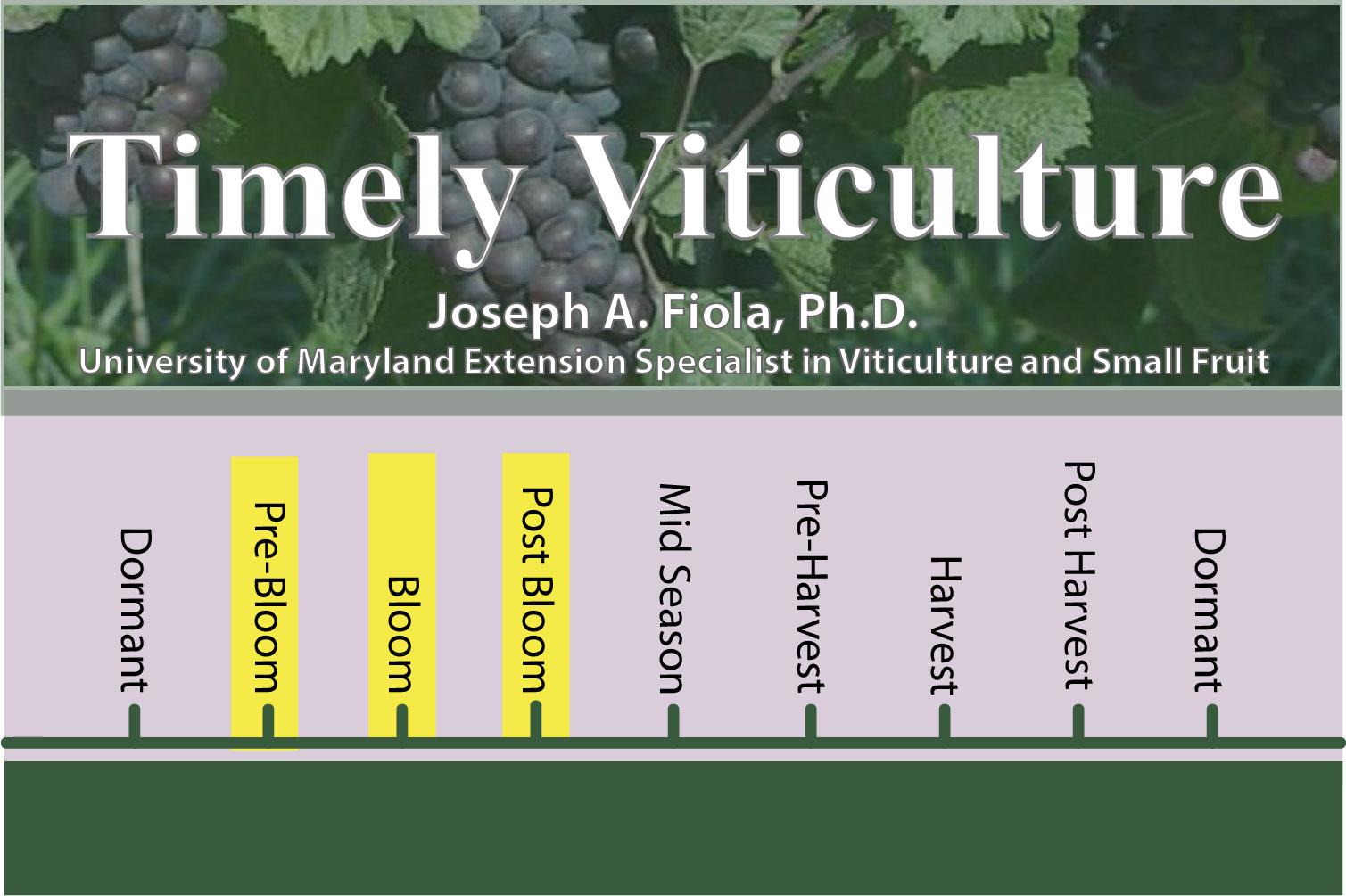Pre-Bloom To Post-Bloom Disease Management
The growth period from 2 weeks pre-bloom until 3 to 4 weeks post-bloom is the most critical for protecting foliage, and especially flowers and newly set fruit from black rot (BR), Phomopsis (Ph), powdery mildew (PM), Downy mildew (DM), and Botrytis bunch rot infections. As each disease has a specific set of temperature and moisture requirements, as well as specific infection timing, growers should apply a series of fungicides to protect the susceptible young tissue before the diseases become established. Proper attention to disease management during this period will make management considerably easier the rest of the season. Conversely, stretching or skipping applications during this period may result in an increase in the inoculum and early infections, making management very difficult the remainder of the season. As always, close attention should be paid to maintaining proper shoot density and an open canopy which will decrease disease pressure.
Immediate Pre-bloom to Early Bloom
- At immediate pre-bloom, inflorescences are fully developed and flower buds are separating; bloom begins with capfall (Eichhorn-Lorenz stages 17–19). Apply a pre-bloom spray at this stage or 10 days after the last shoot spray.
- From pre-bloom through post-bloom, use the most effective fungicides for BR and Ph. Grape berries are susceptible to BR and Ph infection for up to 6 weeks after bloom, though Ph becomes less active as the weather warms up.
- Continue PM protection. If you have successfully protected shoots and foliage from primary PM infections earlier in the season, you will have less inoculum in your vineyard to create secondary infections on fruit and leaves. Berries remain susceptible until they reach 8°Brix, about 4 weeks post-bloom.
- Continue DM protection. It is NOT advisable to use strobilurins (FRAC 11) such as Pristine for DM control, due to the high risk of fungicide resistance. FRAC 11 is highly prone to resistance development, and over 50% of DM populations have developed resistance in the Mid-Atlantic based on limited data. Good choices include mancozeb, captan, or phosphonate (FRAC P07).
- Keep spray intervals at 7–10 days through the post-bloom spray and ensure thorough coverage. Use a 7-day interval if you are applying sulfur for PM or if 2 or more inches of rain have fallen since the last spray. If rain is predicted between 7 and 10 days after the last spray, make the next application before the rain.
Bloom
- Bloom encompasses the stages from capfall to late bloom when up to 80% of the caps have fallen (Eichhorn-Lorenz stages 19–25).
- Most Botrytis fruit infections occur during bloom especially if wet conditions persist during the bloom period. The fungus enters the flower tissue and remains latent (undeveloped) until grapes reach 14+Brix during ripening. A specific application for Botrytis protection is advisable at full bloom in wet years, especially on varieties with tight fruit clusters such as the ‘Pinots’ and ‘Vignoles’. If the weather is dry during bloom, it should be possible to skip the Botrytis spray and save it for other critical periods.
- Continue maximum protection for BR, Ph, and DM (see pre-bloom notes); critical timing for all three.
- Scout for primary PM infections on rachises. If you see actively sporulating colonies, apply a potassium salt (e.g., Armicarb, Kaligreen, Nutrol) as an eradicant, plus sulfur for protection. With thorough coverage, potassium salts provide moderate to good control of developing powdery mildew colonies but no protection against future infections.
Notes:- The use of oil may cause complications: potential delay of fruit ripening, and vine injury when mixing with or within plus or minus 2 weeks of a captan or sulfur spray. Oils are usually used earlier in the season.
- Do not apply protectant fungicides other than sulfur to actively sporulating PM colonies.
- When the use of single-site fungicides (such as FRACs 3, 7, 9, 11, 17 that are at high or medium risk of resistance development) is deemed necessary, remember the following:
- Rotate to a fungicide with a different mode of action at the next spray, and/or tank-mix with a multi-site fungicide (i.e. FRACs M2, M3, or M4)
- Sprays with single-sites should be minimized and are only considered under high infection risk (i.e. extended moisture) during critical periods such as bloom and ripening.
- Limit total applications of these fungicides to no more than 2 per season.
- The use of oil may cause complications: potential delay of fruit ripening, and vine injury when mixing with or within plus or minus 2 weeks of a captan or sulfur spray. Oils are usually used earlier in the season.
Post-bloom
- The post-bloom period spans from late bloom through fruit set (Eichhorn-Lorenz stages 25–27). Apply the first post-bloom spray 7–10 days after the bloom spray.
- Continue protection for BR, Ph, and DM (see pre-bloom notes). Apply a protectant for PM if you do not have active infections. Otherwise, see the bloom notes on eradicants.
- Whether or not you applied a protectant for Botrytis at bloom, the next critical application time will be just before bunch closing, especially for thigh-clustered cultivars.
For more information, contact Dr. Hu at mjhu@umd.edu or Dr. Fiola at jfiola@umd.edu.
Additional resources for grape disease management
- Grapes: Diseases and Insects in Vineyards (pdf)
GRAPES: Weed Control in Vineyards, Horticultural & Forest Crops 2020
Virginia Tech
- Fungicide resistance management-webinar review
Penn State Extension Wine & Grape U.
Thanks to Anne DeMarsay, Ph.D., (former University of Maryland Extension Specialist in Fruit Pathology) for the original version of this TimelyVit.
Timely Viticulture is designed to give those in the Maryland grape industry a timely reminder on procedures or topics they should be considering in the vineyard.
